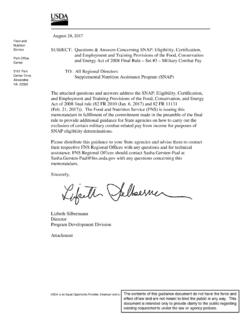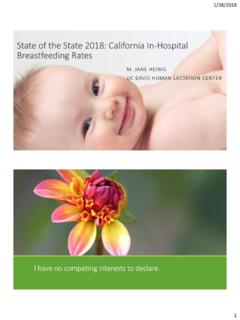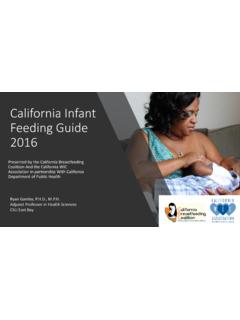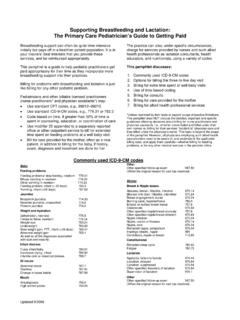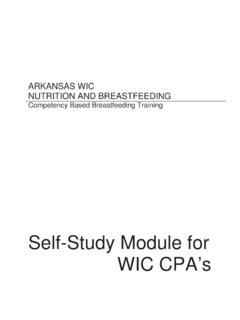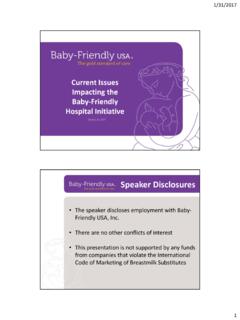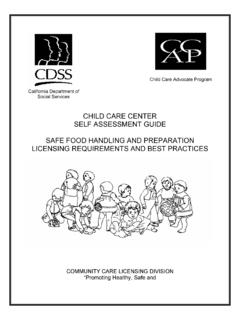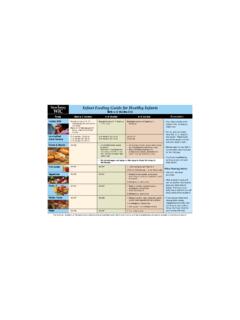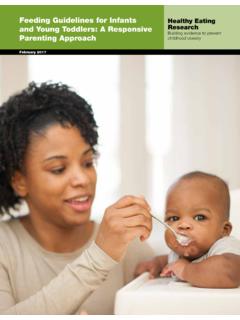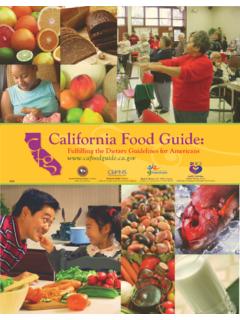Transcription of DATE: MEMO CODE - fns-prod.azureedge.net
1 AN EQUAL OPPORTUNITY EMPLOYER DATE: June 24, 2015 memo code : CACFP 14-2015 ( ) SUBJECT: Infant feeding in the CACFP- Revised TO: Regional Directors Special Nutrition Programs All Regions State Directors Child Nutrition Programs All States The purpose of this memorandum is to consolidate, clarify, and provide additional guidance on infant formula and meal requirements in the Child and Adult Care Food Program (CACFP). This revision clarifies that infant formula must be regulated by the Food and Drug Administration (FDA) in order to be part of a reimbursable meal. Additionally, the memorandum extends the length of time refrigerated breastmilk may be stored at a center or day care home, updates guidance on creditable infant formulas, allows centers and day care homes to serve infant foods containing DHA, and addresses frequently asked questions.
2 This memorandum consolidates and supersedes the following guidance: Policy Regarding the Obligation of a Child Care Facility to Offer Infant Formula in the Child and Adult Care Food Program, December 19, 1996; Issues Related to feeding Infants in the Child and Adult Care Food Program, April 20, 2000; Obligations of Child Care Centers and Day Care Homes to Offer Infant Meals in the Child and Adult Care Food Program, May 17, 2002; Baby Fruits or Vegetables with DHA, December 19, 2002; Reimbursement of Infant Meals in the Child Nutrition Programs, April 28, 2003; and Clarification on Acceptable Infant Formulas, November 9, 2004. Obligation to Offer and Reimbursement of Infant Meals Centers and day care homes participating in CACFP must offer Program meals to all eligible children enrolled in their center or day care home.
3 Program regulations define an enrolled child as a child whose parent or guardian has submitted to an institution a signed document which indicated that the child is enrolled in child care [7 CFR ]. A center or day care home may not avoid this obligation by stating that the infant is not enrolled in the CACFP, or by citing logistical or cost barriers to offering infant meals. Decisions on offering Program meals must be based on whether the child is enrolled for care, not if the child is enrolled in the CACFP. United States Department of Agriculture Food and Nutrition Service 3101 Park Center Drive Alexandria, VA 22302-1500 Regional Directors State Directors Page 2 As long as an infant is in care during the meal service period, the center or day care home must offer the infant a meal that complies with Program requirements.
4 An infant s parents or guardians may, at their discretion, decline the offered infant formula and supply expressed breastmilk or a creditable infant formula for the infant to consume. To receive reimbursement, the center or day care home s caregiver must serve and feed the infant a developmentally appropriate meal. Meals served to infants ages 0 through 3 months containing only breastmilk and/or iron-fortified infant formula that is provided by parents or guardians are reimbursable. Breastmilk Storage The Academy of Breastfeeding Medicine, a worldwide organization of physicians that establishes guidelines for healthy term infants, recommends a storage time of 72 hours for refrigerated breastmilk.
5 Accordingly, in an effort to follow current scientific recommendations, the length of time a center or day care home may keep refrigerated bottles of fresh breastmilk is being extended to 72 hours from the time it was collected. The previously established standard included in the current feeding Infants: A guide for Child Nutrition Programs was 48 hours from the time it was collected. Bottles of fresh breastmilk must be stored in a refrigerator kept at 39o Fahrenheit or below. This change supports breastfeeding practices and increases flexibility for centers and day care homes. FNS will update the feeding Infants: A guide for Child Nutrition Programs ( ) to reflect this change.
6 Centers and day care homes should continue to follow all other breastmilk handling and storage guidelines listed in feeding Infants: A guide for Child Nutrition Programs. Creditable Infant Formulas CACFP regulations require that to be eligible for reimbursement infant formula served must be iron-fortified [7 CFR (b)(2)]. The Food and Drug Administration (FDA) defines iron-fortified infant formula as a product which contains 1 milligram or more of iron in a quantity of product that supplies 100 kilocalories when prepared in accordance with label directions for infant consumption [21 CFR (b)(4)(i)]. The number of milligrams (mg) of iron per 100 kilocalories (calories) of formula can be found on the nutrition facts label of infant formulas.
7 Previously, FNS provided a list of Iron-Fortified Infant Formulas That Do Not Require a Medical Statement. FNS has not updated or provided this list for some time and will no longer maintain such a list due to the continuous development of new or re-formulated infant formula products making an accurate all-inclusive list impractical. The following criteria may be used to determine whether or not a formula is eligible for reimbursement without a medical statement: 1. Ensure that the formula is not an FDA Exempt Infant Formula. An exempt infant formula is an infant formula labeled for use by infants who have inborn errors of metabolism or low birth weight, or who otherwise have unusual medical or dietary problems, as defined in 21 CFR Regional Directors State Directors Page 3 2.
8 Look for Infant Formula with Iron or a similar statement on the front of the formula package. All iron-fortified infant formulas must have this type of statement on the package. 3. Use the nutrition facts label as a guide to ensure that the formula is iron-fortified. The nutritive values of each formula are listed on the product s nutrition facts label. To be considered iron-fortified, an infant formula must have 1 mg of iron or more per 100 calories of formula when prepared in accordance with label directions. Additionally, to be creditable for reimbursement, infant formula must meet the definition of an infant formula in section 201(z) of the Federal Food, Drug, and Cosmetic Act (21 321(z)) ( ) and meet the requirements for an infant formula under section 412 of the Federal Food, Drug, and Cosmetic Act (21 350a) ( ) and the regulations at 21 CFR parts 106 and 107 ( ).
9 Requiring an infant formula be compliant with the FDA regulatory standards on infant formula is consistent with the Special Supplemental Nutrition Program for Women, Infants, and Children s (WIC) infant formula requirements and ensures that all infant formulas served in the CACFP meet nutrient specifications and safety requirements. If a formula is purchased outside of the United States, it is likely that the formula is not regulated by the FDA, and therefore, it may not be creditable under the CACFP. Formulas classified as Exempt Infant Formulas by FDA may be served as a part of a reimbursable meal if the substitution is supported with a medical statement signed by a licensed physician or a State recognized medical authority.
10 A State recognized medical authority for this purpose is a State licensed health care professional who is authorized to write medical prescriptions under State law. The statement must be submitted and kept on file by the center or day care home. FNS recently expanded the list of acceptable medical professionals that may sign a medical statement for meal accommodations for children whose disability restricts their diets. For more information see SP 32-2015, SFSP 15-2015, CACFP 13-2015, Statements Supporting Accommodations for Children with Disabilities in the Child Nutrition Programs, available at Information on FDA Exempt Infant Formula is available at: State agencies should contact the FNS Regional Office in situations where the creditability of an infant formula is uncertain.


